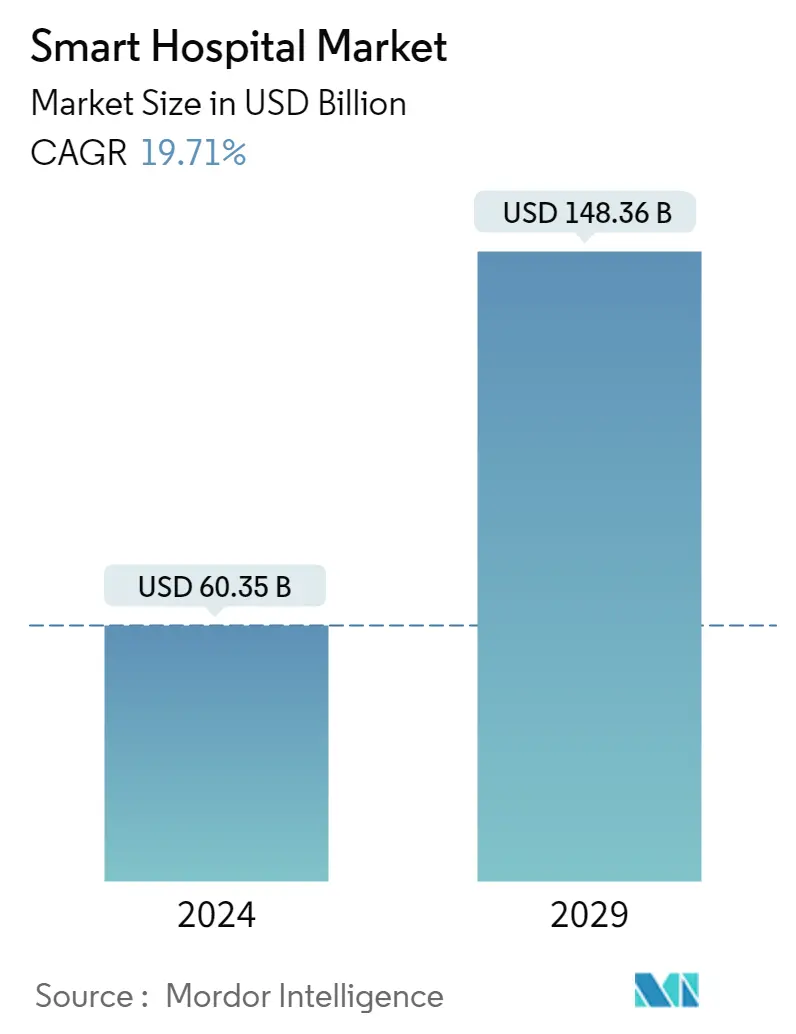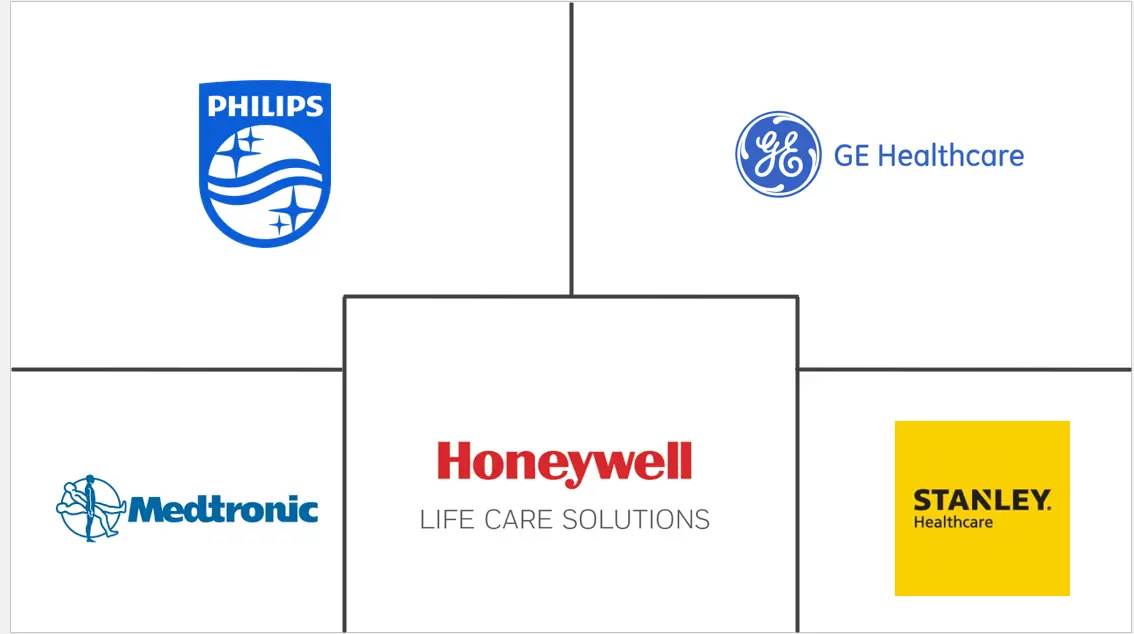Market Size of Smart Hospital Industry

| Study Period | 2019 - 2029 |
| Market Size (2024) | USD 60.35 Billion |
| Market Size (2029) | USD 148.36 Billion |
| CAGR (2024 - 2029) | 19.71 % |
| Fastest Growing Market | Asia Pacific |
| Largest Market | Europe |
Major Players
*Disclaimer: Major Players sorted in no particular order |
Smart Hospital Market Analysis
The Smart Hospital Market size is estimated at USD 60.35 billion in 2024, and is expected to reach USD 148.36 billion by 2029, growing at a CAGR of 19.71% during the forecast period (2024-2029).
The rising trend of the Internet of Things (IoT) continues to transform healthcare delivery services at an unprecedented pace. Connected medical devices are increasing patient safety and efficiency. When such technologies apply to the complete healthcare organization ecosystem, it becomes a "Smart Hospital."
- Due to the high investments involved, hospitals worldwide have been reluctant to adopt these technologies and practices. However, with the diminishing cost of technology and in the light of fast-developing use cases that show the importance of digital connectivity solutions, hospitals today are being forced to embrace them. These technological changes will also benefit hospitals by digitizing personnel management, asset tracking, and scheduling for better operational efficiency.
- Owing to the rise in the aging population and long-term chronic disease conditions in many regions, there is an increasing demand for remote patient monitoring solutions. This is a significant factor impacting the market's growth. There is constant pressure on hospital administrators to lower costs while continuing to improve the standard of patient care. Hospitals are turning to wireless technologies to operate more efficiently, support patient care, and improve their experiences.
- For instance, to better understand and enhance the workflow of nursing staff, hospitals are equipping nurse ID badges with an RFID tag that works with the hospital's Wi-Fi network. These tags track the movement of the nurses throughout their shifts. The data is captured and analyzed, providing insights to the hospitals on how to upgrade their procedures.
- The wireless RFID technology also allows hospitals to track the real-time location of critical equipment and the condition of the equipment. By adopting this wireless technology, the Shands hospital in Florida experienced a 98.8% reduction in the hours spent searching for missing items.
- The COVID-19 pandemic had pushed hospitals beyond their capacity. Yet, the response to the crisis also encouraged innovation. Progressing digital transition was sped up by the requirement to maintain social distance and make the most meaningful use of overworked workers.
Smart Hospital Industry Segmentation
The Smart Hospital market report provides detailed information regarding several segments of smart hospitals, such as hardware, software, and the solutions component. The report analyzes the smart hospital ecosystem and discusses Electronic Medical Records (EMRs), alarm management, research databases, and clinical decision support systems.
The Smart Hospital Market is Segmented by Component (Hardware, Software, and Services), Application (Electronic Health Record, Remote Patient Monitoring, Pharmacy Automation, Mobile Asset Tracking, and Other Applications), and Geography (North America, Europe, Asia-Pacific, and Rest of the World). The market sizes and forecasts are provided in terms of value in USD million for all the above segments.
| By Component | |
| Hardware | |
| Software | |
| Services |
| By Application | |
| Electronic Health Record | |
| Remote Patient Monitoring | |
| Pharmacy Automation | |
| Medical Asset Tracking | |
| Other Applications |
| By Geography | |
| North America | |
| Europe | |
| Asia-Pacific | |
| Rest of the World |
Smart Hospital Market Size Summary
The Smart Hospital market is experiencing significant growth, driven by the integration of Internet of Things (IoT) technologies and digital solutions that enhance healthcare delivery. These advancements are transforming traditional hospitals into smart hospitals by improving patient safety, operational efficiency, and care standards. Despite initial hesitance due to high costs, the decreasing price of technology and compelling use cases are encouraging hospitals to adopt these innovations. The demand for remote patient monitoring solutions is rising, fueled by an aging population and chronic disease conditions, which further propels market expansion. Hospitals are increasingly utilizing wireless technologies to streamline operations, support patient care, and enhance experiences, as evidenced by the implementation of RFID tags for tracking staff and equipment.
The market is characterized by strategic investments, collaborations, and technological innovations, with key players like Koninklijke Philips NV, GE Healthcare, and Medtronic PLC leading the charge. European countries are at the forefront, leveraging advanced infrastructure and AI-driven solutions to develop smart hospitals. The rapid adoption of Industry 4.0 in regions like the United Kingdom is also contributing to market growth. Companies are focusing on product launches, research and development, and strategic partnerships to maintain competitiveness. The COVID-19 pandemic has accelerated digital transformation, highlighting the importance of smart technologies in managing healthcare challenges. As the market continues to evolve, smart platforms and digital solutions are expected to play a crucial role in enhancing healthcare delivery and operational efficiency.
Smart Hospital Market Size - Table of Contents
-
1. MARKET INSIGHTS
-
1.1 Market Overview
-
1.2 Industry Attractiveness - Porter's Five Forces Analysis
-
1.2.1 Bargaining Power of Suppliers
-
1.2.2 Bargaining Power of Consumers
-
1.2.3 Threat of New Entrants
-
1.2.4 Intensity of Competitive Rivalry
-
1.2.5 Threat of Substitutes
-
-
1.3 Industry Value Chain Analysis
-
1.4 Assessment Of The Impact Of COVID-19 On The Market
-
1.5 Market Drivers
-
1.5.1 Modernization of Healthcare Infrastructure is Boosting the Demand for Smart Hospitals
-
1.5.2 Increasing Penetration of Connected Devices and Instruments in Hospitals
-
-
1.6 Market Restraints
-
1.6.1 High Cost of Connected Systems
-
-
1.7 Technology Development
-
1.8 Emerging Use-cases
-
1.9 Key Regulatory Frameworks
-
-
2. MARKET SEGMENTATION
-
2.1 By Component
-
2.1.1 Hardware
-
2.1.2 Software
-
2.1.3 Services
-
-
2.2 By Application
-
2.2.1 Electronic Health Record
-
2.2.2 Remote Patient Monitoring
-
2.2.3 Pharmacy Automation
-
2.2.4 Medical Asset Tracking
-
2.2.5 Other Applications
-
-
2.3 By Geography
-
2.3.1 North America
-
2.3.2 Europe
-
2.3.3 Asia-Pacific
-
2.3.4 Rest of the World
-
-
Smart Hospital Market Size FAQs
How big is the Smart Hospital Market?
The Smart Hospital Market size is expected to reach USD 60.35 billion in 2024 and grow at a CAGR of 19.71% to reach USD 148.36 billion by 2029.
What is the current Smart Hospital Market size?
In 2024, the Smart Hospital Market size is expected to reach USD 60.35 billion.

